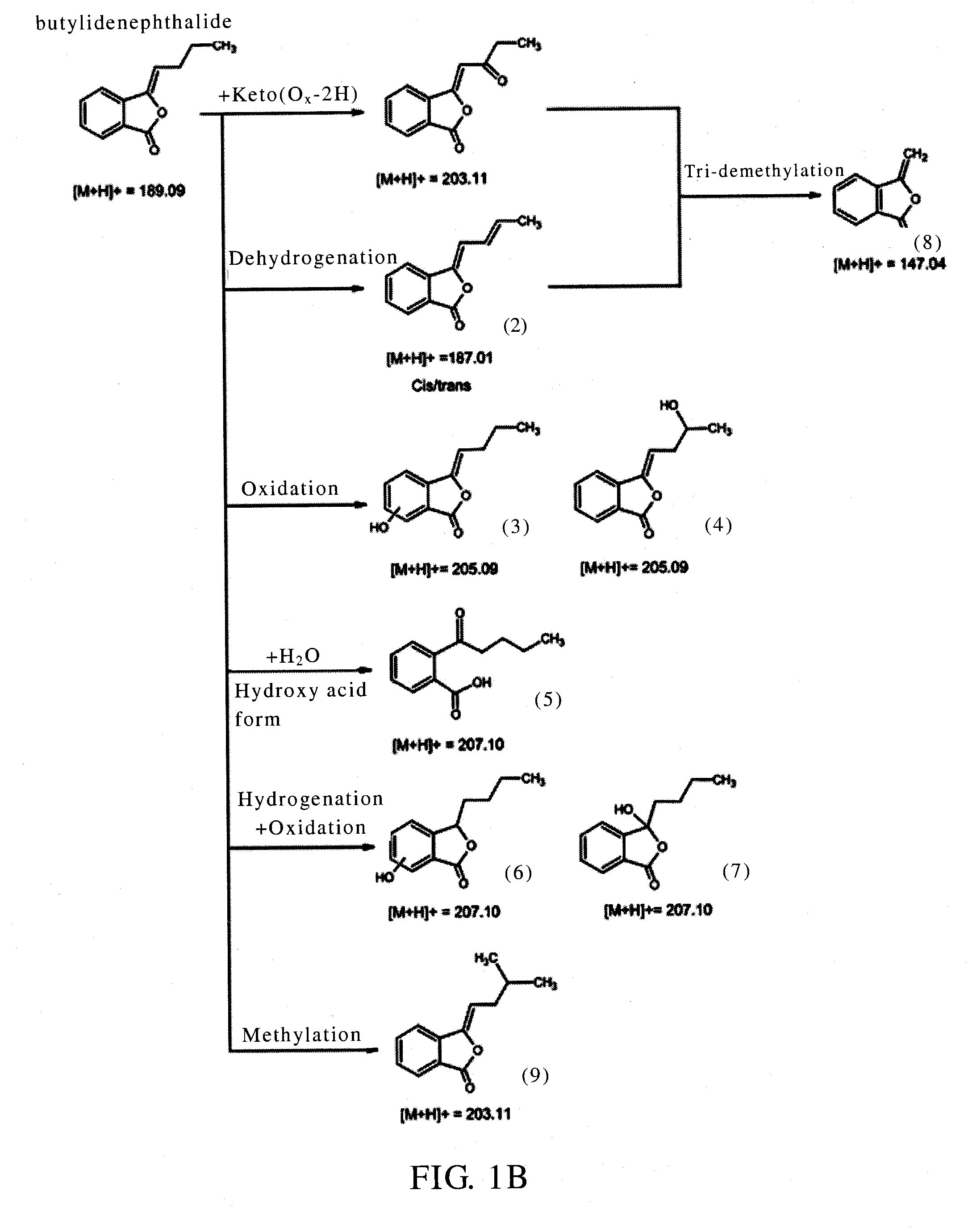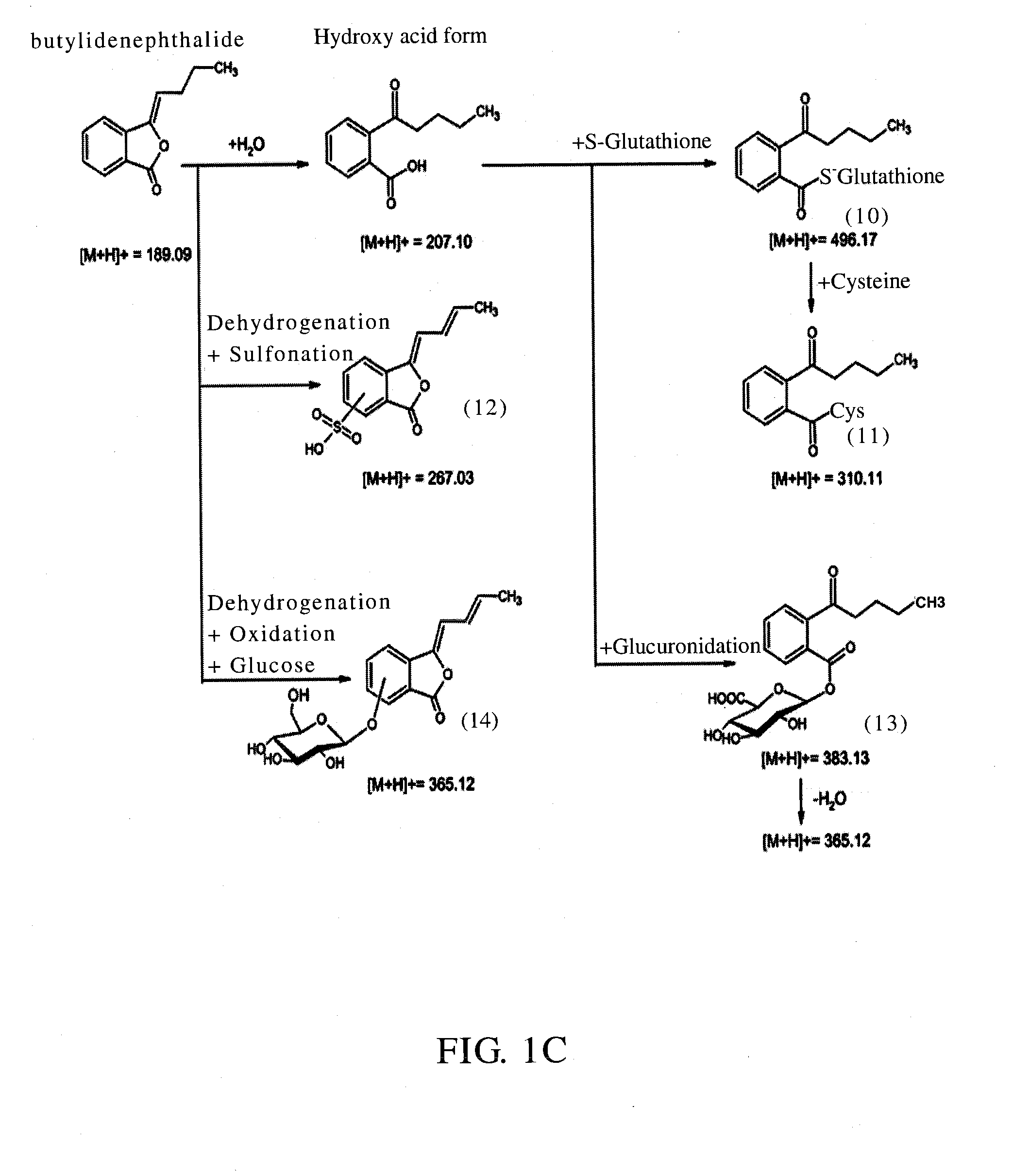Method for inhibiting autophagy of motor neurons
a technology for motor neurons and autophagy, which is applied in the direction of peptide sources, metabolic disorders, applications, etc., can solve the problems of respiratory failure, difficulty in speaking, difficulty swallowing, and inability to achieve significant therapeutic effects, and achieve the effect of inhibiting the autophagy of motor neurons
- Summary
- Abstract
- Description
- Claims
- Application Information
AI Technical Summary
Benefits of technology
Problems solved by technology
Method used
Image
Examples
example
Example 11
Identification of the Metabolites of Butylidenephthalide
[0041]It has been known that the medicine metabolic pathway within an organism's liver can be primarily divided into phase I and phase II metabolism. Phase I metabolism occurs mainly by the redox reaction or hydrolysis reaction of medicine, and phase II metabolism occurs mainly by cytochrome P450 (CYP450) monoxygenase system. This example simulated the phase I and II metabolism of butylidenephthalide that occur within an organism's liver by respectively mixing butylidenephthalide with hepatic microsomes or cryopreserved hepatocytes in vitro, and the products in the reaction solution were analyzed by liquid chromatograph-tandem mass spectrometer (LC-MS / MS) to identify the metabolites and the metabolic profile. The experimental steps were as follows:
[0042](1) Phase I Metabolism Assay
[0043]Butylidenephthalide (2 mM) was mixed respectively with K3PO4 buffer solution (100 mM, pH7.4) containing human, rats or dogs hepatic m...
example 2
In Vivo Analysis: Butylidenephthalide Increases the Survival Rate of Transgenic Mice
[0051]It has been known that about 20% of amyotrophic lateral sclerosis patients were associated with mutations in the gene that encodes Cu / Zn superoxide dismutase enzyme (SOD1), and G93A was the major mutation site. The mice transfected with human mutant SOD1-G93A by gene transfection technique (hereafter referred to as SOD1-G93A transgenic mice) was used as an animal model for the clinical study of amyotrophic lateral sclerosis since the mice exhibit a similar course of disease to human. A SOD1-G93A transgenic mouse will show the symptoms of amyotrophic lateral sclerosis within about 90±5 days postnatal and will die within about 125±5 days postnatal.
[0052]This example used the above SOD1-G93A transgenic mice as the object of study to perform in vivo analysis. SOD1-G93A transgenic mice (60-day-old) were treated with butylidenephthalide (purchased from ECHO Chemical) by oral administration, with a do...
example 3
In Vivo Analysis: Butylidenephthalide Delays the Onset of Amyotrophic Lateral Sclerosis
[0054]SOD1-G93A transgenic mice (60-day-old) were treated with butylidenephthalide by oral administration, with a dosage of 500 mg / kg-body weight once daily. After the mice were treated for 30 days, the hind limbs of the mice were examined by BBB scale (Basso, Beattie, and Bresnahan (BBB) Locomotor Rating Scale). The BBB scale of the hind limbs of normal mice was 21 points, while the BBB scale of disease-progressed SOD1-G93A transgenic mice decreased from 21 to 0 points, wherein the lower scale represents a more severe action disorder in the mice. BBB scale is used to record the drug efficiency.
[0055]As shown in FIG. 4, the 60-day-old SOD1-G93A transgenic mice in the experimental group were treated with butylidenephthalide by daily oral administration. The BBB scale of the hind limbs of the mice decreased slowly from 125 to 135 days (from 21 to 16 points), and decreased rapidly after 135 days (fro...
PUM
| Property | Measurement | Unit |
|---|---|---|
| body weight | aaaaa | aaaaa |
| body weight | aaaaa | aaaaa |
| body weight | aaaaa | aaaaa |
Abstract
Description
Claims
Application Information
 Login to View More
Login to View More - R&D
- Intellectual Property
- Life Sciences
- Materials
- Tech Scout
- Unparalleled Data Quality
- Higher Quality Content
- 60% Fewer Hallucinations
Browse by: Latest US Patents, China's latest patents, Technical Efficacy Thesaurus, Application Domain, Technology Topic, Popular Technical Reports.
© 2025 PatSnap. All rights reserved.Legal|Privacy policy|Modern Slavery Act Transparency Statement|Sitemap|About US| Contact US: help@patsnap.com



